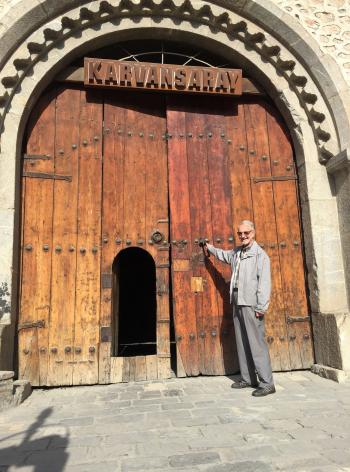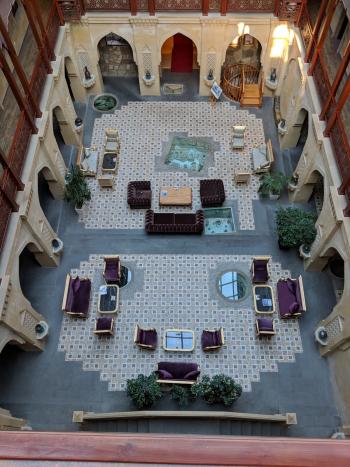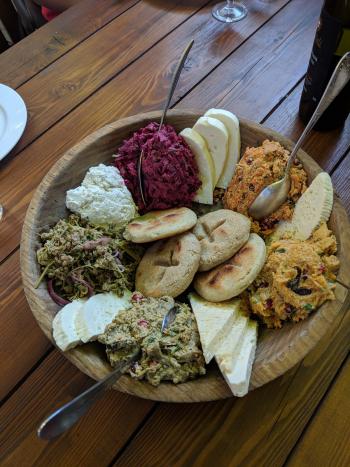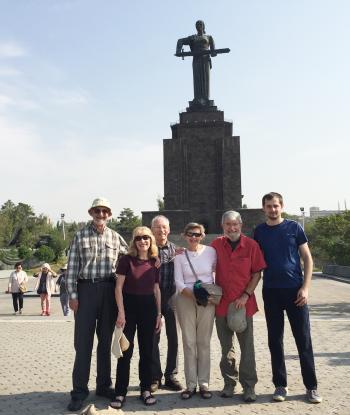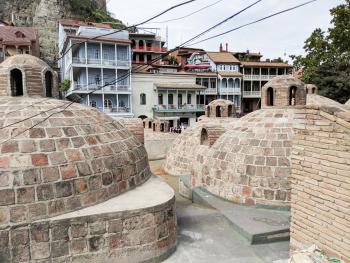Impressed with a guided tour of the Caucasus
This article appears on page 6 of the April 2020 issue.
Our friend David booked a September 2018 tour to Azerbaijan, Georgia and Armenia with his wife, Brenda, then invited my husband, Ken, me and our friend Norman, whom we met last summer in his hometown of Glasgow, to join him. David chose a company in Tbilisi that provides small-group tours (no more than 16) for a reasonable price.
Advantour Caucasus (phone +995 322 323 000, www.advantour.com) took exceedingly good care of us while showing off the Caucasus for a cost of about $3,000 per person for 16 days. (The single supplement was $790, and e-visas for Azerbaijan cost an additional $24 per person.)
Though most dinners and lunches were not included in the tour price, the company generously added meals and a concert as the trip progressed.
Our happy experience was in part due to the excellent leadership of Advantour Caucasus director Yuriy Klyuev, who responded quickly to pre-trip queries and kept in touch with our guides to assure that everything was working well.
We were delighted when Yuriy accompanied (and treated) us to a concert of Georgian polyphony in Tbilisi, and he added (at cost) a special excursion to Dmanisi for two members of our party.
The 2016 edition of Lonely Planet’s “Georgia, Armenia & Azerbaijan” and Reise’s Caucasus map (1:650,000) were helpful supplements to information provided by the local guides.
Getting underway in Azerbaijan
Because interest in this trip exceeded Advantour’s limit, Yuriy added a separate van just for us. Though the vehicles didn’t travel together, we met members of the larger group at most sites.
Three relatively new Advantour employees from Georgia who had not visited the other Caucasus countries joined us for various portions of the trip. Superb travel companions, these charming Georgians gave us insights into the local culture, helped with translation and lent an occasional hand as we negotiated steep stairs and rocks.
The trip covered similar routes and sites described in two previous ITN articles, “Mountains, Monasteries and Museums — A Guided Tour of the Caucasus” by Yvonne Horn (April ’17, pg. 6) and “Monuments, Monasteries and Mountains — A Well-guided Journey through the Caucasus” by Mark Nelson (June ’16, pg. 43).
We started our tour in Baku, the capital of Azerbaijan, where we stayed at the Shah Palace Hotel, located within the Old City walls. Oil riches were evident in the downtown’s contemporary architecture, upscale shops and brightly illuminated streets at night. Local guide Rizvan spent one day showing us the ancient and modern highlights of the city.
A day trip to the Absheron Peninsula featured a petroglyphs museum and mud volcanoes in Gobustan National Park.
To reach the mud volcanoes from the main highway, we hopped into dusty old taxis, their drivers racing one another across the many tracks in the bumpy, moonscape terrain.
Little percolating pots of bubbling gray mud spitted and splashed, the result of gas escaping from hydrocarbons or petrochemicals below the Earth’s surface.
Later in the afternoon we visited the Ateshgah Fire Temple, where Zoroastrians from India have traveled to worship the fire fueled by the local oil fields.
Two more days in Azerbaijan took us west of Baku to Juma Mosque in Shamakhi, then through the Girdimanchay River Canyon to Lahich (aka Lahij), a 5th-century village of stone houses where artisans and outdoor vendors offered copperware, colorful woven items and fresh and dried fruits, herbs, teas and rose petals along the cobblestone streets.
In Sheki, we lodged at the Marxal Resort & Spa. In the morning, Rizvan took us to Sheki’s historic caravanserai, a 2-story arcade surrounding a courtyard where merchants along the Silk Road once rested their teams of camels and opened up shop. We strolled in the open-air bazaar, which offered goods from housewares to clothing along with brilliant produce and meat carcasses for roasting.
Sheki’s Khan’s Palace, built in the 18th century and shaded by two plane trees planted in 1530, is memorable for its decorated ceilings that once matched lavish carpets on the floors. Stained glass from Venice was imported for the windows and other decoration.
On to Georgia
At the Azerbaijan border with Georgia, we walked across a high bridge over neutral territory, a rocky river bottom where cows grazed on scattered grassy patches. Once we’d completed the crossing, our first Georgia guide, Anna, treated us to a bountiful lunch in the backyard gazebo of a private home.
Nearby, at the Winery Khareba, we passed vehicles of all sizes laden with the fall harvest of purple and white grapes. Khareba offered us a sampling of both traditional (pulp, skins, stems, seeds) and European style (pulp only) pressings in their cellars, a tunnel carved from rock and originally built for military purposes.
Afterward, in a slight stupor, we rode on to Gremi, a 16th-century royal residence and capital of Georgia’s Kakheti Kingdom. We stopped for the night at Lopota Lake Resort & Spa.
The next morning, still north of Tbilisi in the Kakheti region, we toured the Chavchavadze Estate at Tsinandali, a home of Georgian dukes. Rooms in the house have been restored to their 19th-century style. We strolled in the English garden and sampled wine from the on-site cellars.
At Sighnaghi, a fortified city along the Great Silk Road, we walked and climbed along a portion of the nearly 2½ miles of walls and defensive towers built in the 18th century, enjoying expansive views of the Alazani Valley in the distance.
As our van arrived in Tbilisi at dusk, we marveled at the mixture of historic and modern buildings nestled along and above the Kura River. We stayed at the River Side Hotel, within walking distance of the Old Town.
I was pleased to discover Caucasian Carpets Gallery in Old Town, and I purchased two small rugs, which reached home before I did! We enjoyed a sumptuous traditional dinner at Tsiskvili, complete with Georgian wine and a traditional dance performance.
A new guide, Nana, joined us for travels along the Georgian Military Highway north of Tblisi. We admired Jvari Monastery, an architectural masterpiece of the Early Middle Ages overlooking the confluence of the Aragvi and Mtkvari rivers.
The weather continued to be sunny and cool for our next stop, the Ana nuri castle complex, which contained churches and towers overlooking the Jinvali reservoir, but as we climbed in altitude, the skies darkened and a spectacular display of thunder and lightning accompanied rain that turned to hail.
We have abiding gratitude for the nerve and skill of our driver Mirab, who took us safely over Jvari Pass (7,815 feet) in several inches of icy slush.
The storm abated sufficiently at Kazbegi, close to the Russian border, so we could take 4-wheel-drive vehicles to the Gergeti Trinity Church, located just below Mount Kazbegi (at around 16,500 feet). Despite intermittent thunderclaps and persistent drizzle, we scurried up a cobblestone path to the shelter of the church. David considered proclaiming himself a monk to avoid the climb back down.
Heading south again, we spent the night at the Marco Polo Hotel in Gudauri, where early risers photographed snowcapped Mount Kazbegi before clouds rolled in once again.
On the drive back to Tbilisi, we toured Stalin’s birthplace in Gori as well as Uplistsikhe, a cave town dating to the Hellenistic period and notable for its various styles of cut rock and the coexistence of pagan and Christian architecture.
On our last day in Georgia, David and Ken went to Dmanisi with Nana and Mirab to see the earliest hominin crania outside Africa, excavated by Georgian archaeologists, while Brenda, Norman and I revisited Tblisi’s Old Town at a leisurely pace.
In the evening, we joined Yuriy for a concert of Georgian polyphonic music performed by the Rustavi Ensemble at the Kakhidze Music Center.
Armenia
Like other Caucasus tours, ours concluded with a visit to Armenia, where we changed local guides and drivers once again. Shush welcomed us aboard, and we headed toward Armenia’s capital city, Yerevan.
On the way, we stopped at the Haghpat Monastery that overlooks the Debed River. A UNESCO World Heritage Site, Haghpat represents traditional Armenian architecture of the 10th to 13th centuries.
At Sevanavank, we climbed above Lake Sevan, one of the largest high-mountain freshwater lakes in the world, to see the Black Monastery, remnants of two temples constructed from black tuff (formed from volcanic ash) and standing among numerous carved cross-stones (khachkar), monuments each adorned with a carved cross and decorated with botanical and lace designs.
Lovely Yerevan, almost pink in the glow of the rosy tuff rock of its buildings, has been well described by the previously mentioned ITN authors.
Our Yerevan tour included a morning of stops at the “Mother Armenia” statue, the Armenian Genocide Museum and the Cascade Monument.
After lunch, we toured the Etchmiadzin Cathedral complex, comparable to the Vatican for the Armenian Apostolic Church.
When I asked if rugs were made in Yerevan, Shush and Advantour arranged an impromptu visit to the Megerian carpet factory and museum, where we watched hand-weaving demonstrations and then admired a historical collection of intricate designs produced during the company’s more than 100 years in business.
That evening we devoured a traditional Armenian dinner at Tavern Yerevan. The menu included pumpkin soup, numerous eggplant and tomato concoctions, and lamb and chicken kebabs. I had my first taste of Armenian harissa, a porridge of roasted cracked wheat and chicken stock — true comfort food — and we all had baklava for dessert.
From Yerevan, we continued south to the Khor Virap monastery with its impressive, iconic view of Mt. Ararat. Khor Virap is the monastery where Gregory the Illuminator was imprisoned before being freed and converting Armenia to Christianity.
From there, we drove to the Areni-1 Cave Complex, where archaeologists in 2008 discovered a leather shoe determined to be some 5,500 years old. Continuing southeast, we reached Goris, a town located near the Nagorno-Karabakh region contested by Armenia and Azerbaijan.
The next morning we took a 3½-mile cable car ride over two deep gorges to see Tatev Monastery, which flourished in the 9th to 13th centuries. An architectural jewel deep in the mountains, Tatev was once the religious and political center of the region.
Though a winding road connects Tatev with the highway, the Wings of Tatev tramway, the longest nonstop double-track cable car in the world, whisks visitors across the gorge in 12 minutes.
Returning to Yerevan, we found a superb Armenian/French-fusion restaurant, The Club (40 Tumanyan St.), for dinner. As we strolled through Republic Square afterward, around 10 p.m., the fountain-and-light show was in full swing, and exuberant crowds, including many young children, were enjoying it greatly.
Following a last day of touring, our final dinner in Yerevan, at the Lebanese-Armenian restaurant Babig, was a celebration of local cuisine with good friends and traveling companions.
We have wonderful memories from this trip, our first-ever guided tour, and we highly recommend Advantour for future visitors to this less-traveled part of the world.

